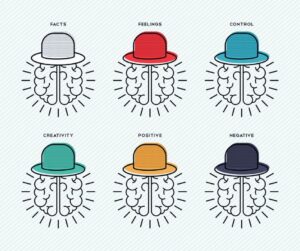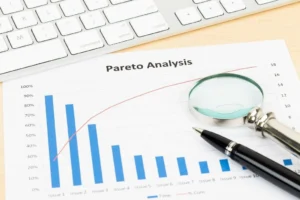Analysis paralysis is a situation where you overthink things. You get stuck in a loop of evaluating every possible option. Making progress becomes difficult because you spend too much time analyzing instead of acting.
If you’re reading this, you likely want to break free from this paralysis. Let’s dive into understanding and overcoming this challenge!
What is Analysis Paralysis?
Analysis paralysis happens when you spend too much time analyzing a situation. You want to make the perfect decision. So, you consider every angle and option. But the more you analyze, the harder it gets to decide!
Say you want to buy a new laptop. You start researching laptops online. The more you read reviews and compare models, the more confused you get. Should you get a Windows or Mac? What about storage and RAM? Soon, you’re paralyzed by indecision!
While some analysis is good, too much analysis paralyzes you. It leads to inaction. Does this resonate with you? If so, read on to understand the root causes.
Causes of Analysis Paralysis
There are several reasons why people get stuck in analysis paralysis:
- Fear of making the wrong choice: You worry about regretting your decision later. So you analyze endlessly, hoping to eliminate any chance of error.
- Perfectionism: You want the best outcome, not just a good one. Perfectionism drives you to over-analyze to find the “perfect” solution.
- Too much information: With so much data available, you feel compelled to scrutinize every detail before deciding. However, this information overload leads to confusion.
- Lack of confidence: You doubt your abilities to make good decisions. The constant analysis seems safer than trusting your judgment.
- Past mistakes: If prior choices didn’t work out, you may analyze excessively to avoid repeating those errors.
Does any of this sound familiar? Recognizing the driving forces behind your paralysis is the first step to overcoming it.
Consequences of Analysis Paralysis
While attempting to make the best choice seems wise, over-analyzing is counterproductive. It leads to:
- Missed opportunities: While stuck in analysis mode, you miss out on time-sensitive opportunities.
- Anxiety and stress: The endless cycle of weighing pros and cons increases anxiety.
- Inability to make decisions: You become so paralyzed that you can’t pull the trigger on any decision.
- Wasted time and effort: All the time spent over-analyzing could have been better utilized to take action.
- Sunk cost fallacy: You invest so much time analyzing that you feel you can’t stop, even if the decision isn’t critical.
Rather than letting analysis paralysis control you, it’s better to make an imperfect decision than no decision at all.
How to Overcome Analysis Paralysis
Fortunately, there are strategies to break free from the paralysis of over-analyzing. Give these a try:
Set a Time Limit
Impose a strict time limit on your analysis and decision process. For example, give yourself 2 days to research and decide on a new laptop model.
“I will spend Friday evening and Saturday reviewing laptops. By Saturday evening, I will choose one model and make the purchase.”
Having a firm deadline forces you to analyze efficiently and commit to a choice within that timeframe. Otherwise, you could analyze forever!
Use the 80/20 Rule
The 80/20 rule states that you get 80% of the value from 20% of the work. So why spend endless time pursuing that last 20%?
Apply this mindset when making decisions:
- Spend 20% of your time up-front gathering key information
- Use that data to make your decision quickly
- Don’t obsess over finding every last detail before deciding
You make good enough progress by riding the 80% solution. Diminishing returns kick in when you overanalyze in pursuit of perfection.
Balance Risk vs Reward
Not all decisions warrant the same level of scrutiny. For higher risk, higher reward scenarios, more analysis is justified. But for lower-risk situations, you can make quicker choices.
Ask yourself:
- What are the potential consequences if I’m wrong?
- How much would I gain if I make the optimal choice?
If the consequences are minor and the gains are small, don’t agonize over the decision. Make a reasonable choice based on limited analysis.
| Decision | Risk Level | Analysis Time |
|---|---|---|
| Choosing retirement investments | High Risk | Thorough analysis warranted |
| Picking a restaurant for dinner | Low Risk | Little analysis needed |
Calibrate your analysis based on the risk/reward balance of each decision.
Learn to Let Go
Sometimes you simply have to accept that you can’t have perfect information. At some point, you have to let go and make a judgment call based on what you know. Letting go reduces stress and frees you to take action.
Realize that:
- Not every decision is permanent; you can change course later
- You’ll never have 100% of the information you want
- Failing to decide is often worse than making an imperfect choice
If your analysis has hit diminishing returns, stop analyzing and start executing! Let go of the pursuit of perfection in favor of making reasonable progress.
Start Small
Analysis paralysis often stems from fear of making mistakes. You can build your decision “muscles” through low-risk practice.
Make smaller, lower-stakes decisions more spontaneously and without over-analyzing. As you build confidence in your abilities, you’ll find it easier to make bigger decisions too.
For example, you could:
- Decide what shirt to wear with less agonizing
- Choose which household chore to do first without much debate
- Pick an appetizer for the table without scrutinizing the entire menu
Get comfortable pulling the trigger on easier choices. Then work your way up to applying that mindset for higher-stakes decisions.
Celebrate Small Wins
Finally, give yourself credit for every small decision you make without over-analyzing! Don’t dismiss these as inconsequential. Celebrate them as vital first steps.
Each time you choose reasonable analysis (versus endless analysis), mark that win. You’re re-wiring old paralysis habits and building new decision-making muscles.
Positive reinforcement reinforces productive behavior. Celebrating small wins boosts your confidence to tackle more complex decisions in the future.
Analysis Paralysis FAQ
Q: Isn’t some analysis a good thing before deciding?
A: Yes. Some upfront analysis is wise and helpful. The goal isn’t to eliminate analysis. It’s to find the right balance and avoid paralysis from over-analysis.
Q: What if I make the wrong choice?
A: Not every decision is permanent or irreversible. If you make a wrong choice, you can often adapt and correct course. Don’t let the fear of being wrong paralyze you completely.
Q: How do you know when you’ve analyzed enough?
A: There’s no perfect answer, but try applying the 80/20 rule we discussed. Once you’ve gathered 80% of the key data, make your decision rather than pursuing that last 20%.
Q: Is taking action always better than inaction?
A: Not necessarily. There are times when inaction or waiting is wiser, such as:
- If the decision absolutely must be perfect (very rare)
- If you’re undergoing a temporary emotional state that clouds your judgment
- If new information that could change the outlook is expected soon
In general, some action is better than complete paralysis and inaction.
TL;DR
Analysis paralysis occurs when you overthink decisions to the point of inaction. While some analysis is helpful, too much gets you stuck in an endless loop.
To overcome this:
- Set firm time limits for your analysis periods
- Apply the 80/20 rule – get 80% of the key info, then decide
- Balance risk versus potential reward when allocating analysis effort
- Practice letting go once you’ve gathered sufficient data
- Start with low-stakes decisions to build decision muscles
- Celebrate each non-paralyzed choice you make
Don’t let the pursuit of perfection through over-analysis lead to complete inaction. Make good enough decisions through reasonable analysis, then adapt as needed. This allows you to keep making progress.





